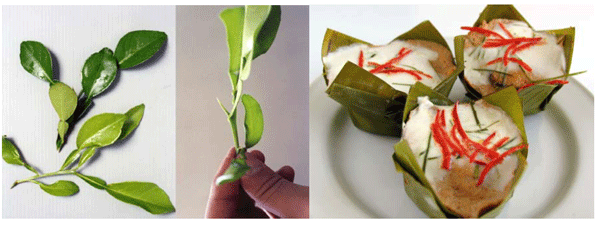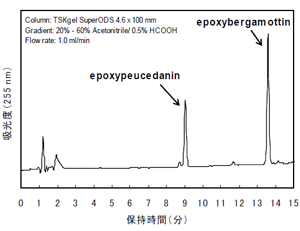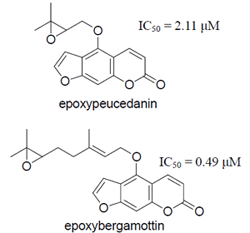Furanocoumarins in leaves of kaffir lime (Citrus hystrix ) prohibit mutagenic DNA damages
Description
It is possible to reduce the risk of carcinogenesis by ingesting sufficient amounts of antimutagenic food components. Thus, antimutagenicity is recognized as an important food functionality. Aiming to look for a good source of antimutagen, we examined several hundreds of Southeast Asian local edible plants using Ames’ pre-incubation technique. Their industrial uses as materials of functional foods or medicines may help improve the economic value of such local agricultural products. Among the tested local edible plants, kaffir lime (Citrus hystrix) leaves showed one of the highest antimutagenic activities. Kaffir lime leaves have a unique fresh aroma and are widely consumed as an ingredient of food in Southeast Asia, especially in Thailand (Fig. 1).
The methanolic extract of kaffir lime leaves shows a strong antimutagenicity against heterocyclic amines (food-originating mutagens). The extract obtained from 1 mg of fresh leaves inhibit 90 – 100% of mutagenesis induced by 1 ng / plate of Trp-P-1. There are rather small variations of antimutagenicity between samples obtained from different production areas or seasons. And, the antimutagenicity of kaffir lime leaves doesn’t deteriorate even after high temperature cooking at 100°C for 10 minutes. Major antimutagenic compounds in kaffir lime leaves are epoxybergamottin and oxypeucedanin (Fig. 2 and 3). These compounds are furanocoumarin derivatives having an epoxylated prenyl group in their molecule. Both compounds show antimutagenicity by inhibiting the liver cytochrome P450 enzymes that activate the mutagens’ effects. Epoxybergamottin is a more promising compound, since its content in raw material is higher than oxypeucedanin, and shows lower IC50 value (higher antimutagenicity).
Antimutagenic compounds in kaffir lime leaves are insoluble in water. Therefore, it is necessary to arrange the cooking recipe to make it possible to eat the leaves, e.g. slicing in small pieces, frying, etc. It is already known through other studies that prenylated furanocoumarins are absorbed into the human body.
Figure, table
-
Fig. 1. Kaffir lime leaves (left and middle); a Thai food which uses kaffir lime leaves, “ho-mok”- steamed fish paste with coconut milk (right) -
Fig. 2 HPLC profile of methanol-ether extracts of kaffir lime leaves. Two dominant peaks are of antimutagens. -
Fig. 3 Antimutagens of kaffir lime leaves.
IC50 value is the 50% inhibitory concentration of each compound against ethoxyresorufin O-deethylase activity of liver cytochrome P450s.
- Affiliation
-
Japan International Research Center for Agricultural Sciences Post-harvest Science and Technology Division
- Classification
-
Administration B
- Term of research
-
FY2009(FY2006~2010)
- Responsible researcher
-
NAKAHARA Kazuhiko ( Post-harvest Science and Technology Division )
Yoshida Mitsuru ( National Food Research Institute )
KAKEN Researcher No.: 60353992Trakoontivakorn Gassinee ( Kasetsart University )
Tangkanakul Plernchai ( Kasetsart University )
- ほか
- Publication, etc.
-
Nakahara et al. Annual Meeting of the Japan Society for Bioscience, Biotechnology, and Agrochemistry, Fukuoka 2009 p.14
- Japanese PDF
-
2009_seikajouhou_A4_ja_Part11.pdf102.46 KB



